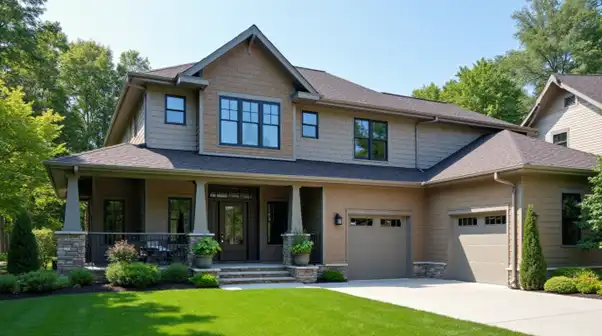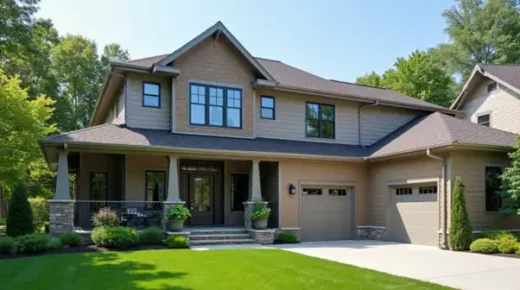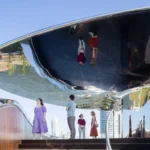Siding and architecture, what every homeowner should know, Property exterior guide, Real estate glazing tips
Siding and Architecture: What Every Homeowner Should Know
25 April 2025
The Evolution of Residential Siding
Siding has always played a central role in shaping the look and performance of American homes. From hand-cut wooden boards on colonial farmhouses to sleek, engineered panels on today’s custom builds, exterior cladding continues to evolve with architecture. Early siding was chosen mainly for function—to protect structures from the elements. Over time, style, color, and detail became just as important.
As technology advanced, so did the materials. The introduction of vinyl siding in the mid-20th century brought affordability and ease of maintenance, while fiber cement and metal siding opened the door to new textures and design flexibility. These innovations gave homeowners and architects more tools to express identity through exterior surfaces without sacrificing durability.
Today, siding is more than a covering—a design decision. Siding must meet aesthetic and environmental demands in places like New Jersey and Pennsylvania. That’s why many homeowners turn to experienced professionals for siding repair NJ services that prioritize structural integrity and curb appeal. A well-executed siding solution doesn’t just patch the surface—it respects the home’s design language while protecting it from the tough Northeast climate.
Across neighborhoods, we see regional styles influencing material selection. Cape Cods with cedar shakes, mid-century homes with wide panel vinyl, and modern builds featuring mixed materials like metal and wood each tell a story. This article explores how siding works as an architectural element, how materials convey design intent, and why the right siding choice adds lasting value to any home.
The Architectural Expression of Different Sidings
Vinyl Siding – The Balance of Practicality and Design
Vinyl siding has come a long way from its utilitarian beginnings. Once viewed purely as a low-maintenance substitute for wood, it now offers an impressive range of textures, profiles, and colors. Modern vinyl can mimic wood grain, board-and-batten patterns, or even stone looks—providing design flexibility that fits both traditional and contemporary homes.
Its affordability and resistance to rot and insects make it a practical option, especially in regions with varying weather. Vinyl strikes a solid balance between performance and appearance for residential properties across NJ and PA. Local professionals offering siding repair services often recommend vinyl as a dependable, versatile solution for homeowners looking to update or restore their exteriors without a full replacement.
Vinyl also allows for contextual design. In suburban settings, muted earth tones and subtle textures blend well with landscaped lots. In urban environments, bolder colors and clean lines offer contrast and definition. It’s a material that adapts to the home’s surroundings while simplifying upkeep.
Wood Siding – Traditional Warmth with Modern Applications
Wood siding remains one of the most timeless and expressive options for residential design. Its natural warmth and texture bring a character that synthetic materials often try to replicate. From vertical cedar planks to horizontal lap siding in redwood or pine, the grain and tone of wood can dramatically impact a home’s personality.
Architecturally, wood is highly adaptable. It enhances rustic cabins, craftsman bungalows, and colonial estates alike. When maintained properly, wood can last for decades—and when it weathers, it does so with grace. However, it requires a commitment to care. Paints, stains, and sealants must be refreshed regularly, and damage from moisture or pests needs to be addressed quickly.
In high-end remodels and historic restorations, wood remains unmatched in authenticity. It’s not just about looks—wood offers texture, depth, and a living quality that gives façades movement and life. Used selectively, it can create rich contrasts when combined with more modern materials.
Fiber Cement – The Modern Compromise
Fiber cement has become a go-to siding material for architects and builders who want strength without sacrificing visual appeal. A blend of cement, sand, and cellulose fibers, this material offers the dimensional look of wood with better durability and fire resistance.
Its biggest draw is flexibility. It works across architectural styles, from classic American foursquare to ultra-modern builds. Panels can be smooth and minimalist or designed with deep-grain textures for a more natural feel. It also takes paint well, holding color longer than traditional wood.
In climates like those in NJ and PA, where temperature shifts and moisture are a concern, fiber cement stands up to the elements while delivering a clean, tailored finish. It’s a smart middle ground for homeowners who want long-term performance and aesthetic control. Fiber cement can often be matched or upgraded with minimal visual disruption for homes requiring selective siding repair or partial replacement.
Metal Siding – Contemporary Expressions
Metal siding has moved beyond industrial zones and into the residential spotlight. Materials like steel and aluminum are now featured on modern homes as bold architectural statements. Clean lines, matte finishes, and reflective surfaces all contribute to the appeal, especially in contemporary and minimalist designs.
Designers use metal for contrast, often combining it with wood or concrete for striking results. Its crisp geometry emphasizes shape and shadow, giving buildings a sense of precision. Metal panels can be smooth, ribbed, or corrugated, depending on the intended visual impact.
Beyond aesthetics, metal siding offers superior durability. It resists fire, pests, and weather extremes with little maintenance. In regions where winter storms and summer humidity test materials, metal proves stylish and tough. Used in the right context, it brings dynamic energy to the building envelope, reflecting changing light and creating movement across the surface throughout the day.
Regional Architecture and Siding Choices
Siding isn’t chosen in a vacuum. Local climate, architectural heritage, and even neighborhood trends influence what works—and what lasts. In the Northeast, where homes face harsh winters, humid summers, and salty coastal air, siding must be more than just attractive. It has to be built for the environment.
Regional building traditions in New Jersey and Pennsylvania still guide many siding choices. Cape-style homes near the coast often feature shingles or clapboard profiles. At the same time, brick-front colonials in the suburbs may use fiber cement or vinyl as a complementary material on side elevations. Modern townhomes in cities like Philadelphia or Jersey City push toward metal accents and bold palettes to reflect urban energy.
As local codes evolve and sustainability becomes a focus, siding decisions are also becoming more informed. Homeowners want materials that perform well year-round, reflect local style, and enhance curb appeal without constant maintenance. The result? A move toward smart, contextual cladding choices that bridge tradition and technology.
Coastal Considerations
For homes along the Jersey Shore or Delaware Bay, siding has to do more than look good—it needs to stand up to wind, rain, and salt. Corrosion-resistant materials like vinyl and aluminum are popular for these reasons. They don’t absorb moisture, won’t rot, and resist warping under sun and spray.
Color choices also lean coastal: soft blues, whites, and grays that mirror the ocean and sky. These hues help homes blend into their surroundings while staying cool under direct sun. Architects often choose board-and-batten profiles or horizontal lap siding to give coastal homes a classic but resilient look.
Structural upgrades like moisture barriers, impact-rated panels, and reinforced trim systems ensure the entire façade works together to defend against the elements. When done right, coastal siding protects and enhances a shoreline property’s breezy, timeless feel.
Urban Context and Material Selection
In dense city neighborhoods, siding takes on another role—it becomes part of the streetscape. Here, siding must speak to the building’s character and relationship with nearby structures. Materials must perform well, but they also must contribute to the city’s visual rhythm.
Fiber cement and metal siding are popular in urban renovations because they combine performance with sharp lines and flexibility. They work well with brick, glass, or stone and offer improved noise control—a key advantage for homes near traffic or public transit.
Historic districts present unique challenges. Many homeowners and designers work with siding that honors original architecture while improving energy efficiency and reducing maintenance. Narrow vinyl planks, wood-look fiber cement, or real cedar can all be used to stay true to a home’s past while meeting today’s standards.
The Sculptural Qualities of Siding
Siding does more than shield a home from weather—it defines form through texture and shadow. The profile, relief, and panel depth can add sculptural quality to any façade. Vertical lines elongate, horizontal lines ground, and irregular patterns create rhythm.
Modern architecture often emphasizes this effect. Deep-grooved panels and standing seams create bold shadow lines that change with the sun’s angle. Even in traditional homes, subtle textures—like wood grain or staggered shakes—add character and depth.
Mixing materials further enhances this visual dimension. Pairing smooth fiber cement with rough cedar or matte metal with stone veneer creates contrast that draws the eye. The result is a layered, custom look that feels thoughtful and architectural, not just decorative.
Color Theory in Exterior Design
Color is one of the most powerful residential design tools— siding is its largest canvas. The right color can make a home feel warm, modern, timeless, or bold. It also affects how large or small a building appears and how well it fits its surroundings.
For traditional homes, earth tones, warm grays, and off-whites remain popular. Modern builds often lean toward dark charcoals, soft black, and natural wood stains. Coastal and cottage-style homes stick to light blues, creams, and misty greens.
But it’s not just about preference. Color fastness—the ability to resist fading—is critical in sunny, humid, or storm-prone regions. High-quality siding materials with UV protection and baked-on finishes help maintain color integrity for decades, reducing the need for repainting or replacement.
At American Quality Remodeling, we help homeowners choose siding colors that match architectural style, improve resale appeal, and hold up beautifully under Northeast conditions.
Combining Materials for Architectural Interest
Blending multiple siding materials on a single façade is no longer just a trend—it’s a widely adopted architectural strategy that adds depth, character, and sophistication to residential design. Using a mix of textures, colors, and profiles, homeowners and designers can break up large surfaces, highlight key features, and create custom visual interest that elevates curb appeal.
One common approach is to use a contrasting material as an accent—such as pairing vertical metal panels with horizontal fiber cement or placing natural wood siding at the entryway while using vinyl or composite elsewhere. This method draws attention to focal points like gables, porches, or window groupings and helps define architectural hierarchy.
Material contrast also aids in functional zoning. For example, durable fiber cement may be used on lower portions of the home where impact resistance is important, while lighter materials like vinyl or engineered wood appear above. This not only protects vulnerable areas but also adds a natural rhythm and balance to the design.
These combinations work especially well when coordinated by color and proportion. A muted base color can ground the home, while textured accents—like shingles or board-and-batten—add movement and interest. When thoughtfully executed, hybrid siding design communicates intentionality, craftsmanship, and modern style—all while meeting practical performance goals.
In today’s market, where homeowners seek both uniqueness and long-term value, hybrid siding strategies offer an ideal middle ground between form and function. They allow for design freedom while enhancing the building envelope’s performance and adaptability.
Comments on this guide to Siding and Architecture: What Every Homeowner Should Know article are welcome.
Windows
Windows Posts
Buying new window treatments for your home
5 creative uses of glass in architecture
7 reasons why you should replace your old glass windows
Architecture Designs
Home Designs
Comments / photos for the Siding and Architecture: What Every Homeowner Should Know – Expert window installation by UCT Roofing page welcome






